

NAB fights with one hand tied. Cameron Clyne.
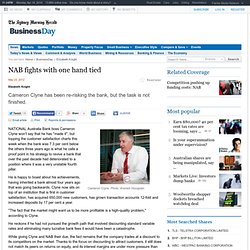
Photo: Arsineh Houspian NATIONAL Australia Bank boss Cameron Clyne won't say that he has ''made it'', but topping the customer satisfaction charts this week when the bank was 7.3 per cent below the others three years ago is what he calls a proof point in his strategy to revive a bank that over the past decade had deteriorated to a position where it was a very unstable fourth pillar. He is happy to boast about his achievements, having inherited a bank almost four years ago that was going backwards. Clyne now sits on top of an institution that is first in customer satisfaction, has acquired 650,000 new customers, has grown transaction accounts 12-fold and increased deposits by 17 per cent a year. ''The fact that the market might want us to be more profitable is a high-quality problem,'' according to Clyne.
He reckons if he had not pursued the growth path that involved discounting standard variable rates and eliminating many lucrative bank fees it would have been a catastrophe. Big four can’t afford the full cut. Banking sector profits growing worldwide - Inside Business - ABC. ALAN KOHLER, PRESENTER: Just on the subject of banks, there was a rueful comment from the CEO of David Jones Paul Zahra this week.

He said, "We know where the money is - the banks have it. " So, it's extraordinary, isn't it, the bank debate just keeps going on and on? And with politicians getting stuck into them, which we'll talk about a bit later. But what did you think of where the Commonwealth Bank came out this week with its result? Such a contrast to Qantas too I suppose.
TOM ELLIOTT, CIO, BEULAH CAPITAL: Well I thought the CBA result was fantastic. JOANNE GRAY, OPINION EDITOR, AUST. GERARD MINACK, STATEGIST, MORGAN STANLEY: The bread and butter of banks is still writing loans and we've seen this huge escalation in debt-to-GDP in Australia and you think it's got to go sideways or down. ALAN KOHLER: You've been doing some work on financial sector profits around the world and producing some very interesting graphs on that subject, Gerard. (Laughs from panellists). Australian banks. ANZ's cash profit is a bit better than the market expected.
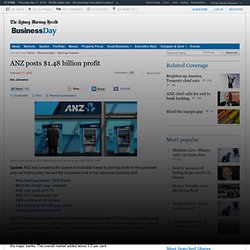
Photo: AFP Update ANZ has completed the quartet of Australian banks to post big profits in the past week even as funding costs rise and the companies look to trim expenses including staff. Timing of the essence in taking banks for a ride. SOMETIMES trying to pick the eyes out of sectors rather than individual stocks can be a low-risk and profitable exercise.

Early last month we looked at the seasonality of the banking sector since the 45-day holding period for franking was introduced in 1997. Research by Veritas Securities analyst Andrew McCauley revealed that it is most beneficial to own Australia's big four banks in March, April and October. Investors buy into the banks so they qualify for franking when three of the big four banks go ex-dividend in late May or early June and again in November.
The data shows the banking sector has, on average, risen 5.3 per cent in the consecutive months of March and April since 1997. In October the sector has another spurt, jumping on average 3.74 per cent. Advertisement Obviously, the sector is like a magnet for investors hooked on large, fully franked dividends. As we approach the end of April, this year's performance has mirrored previous years. Australia Tops OECD Better Life Index. Suncorp Bank to issue covered bonds. TEXT-Fitch rates Suncorp-Metway covered bonds 'AAA(exp)' Mon May 21, 2012 12:10pm IST (The following statement was released by the rating agency) May 21 - Fitch Ratings has assigned Suncorp-Metway Limited's (SML, 'A+'/Stable/'F1') inaugural residential mortgage covered bonds, an expected 'AAA(exp)' rating.

Www.rba.gov.au/publications/smp/boxes/2012/feb/d.pdf. Unintended consequences of covered bonds. Recently Australia passed legislation so that Australian ADI’s can issue covered bonds and last week APRA released a paper and APS 121 Guidelines on how APRA is going to regulate the issuance and management of covered bonds.
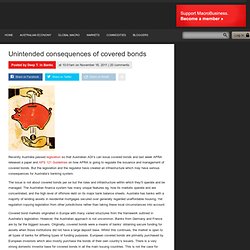
But the legislation and the regulator have created an infrastructure which may have serious consequences for Australia’s banking system. The issue is not about covered bonds per se but the rules and infrastructure within which they’ll operate and be managed. The Australian finance system has many unique features eg, how its markets operate and are concentrated, and the high level of offshore debt on its major bank balance sheets.
Australia has banks with a majority of lending assets in residential mortgages secured over generally regarded unaffordable housing. Yet regulation copying legislation from other jurisdictions rather than taking these local circumstances into account. Banks downplay ratings downgrade. Jonathan Shapiro, George Liondis and John Kehoe Banks have been anticipating the downgrade all year.
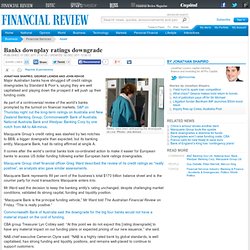
Photo: Joe Armao Major Australian banks have shrugged off credit ratings downgrades by Standard & Poor’s, saying they are well capitalised and playing down the prospect it will push up their funding costs. As part of a controversial review of the world’s banks prompted by the turmoil on financial markets, S&P on Thursday night cut the long-term ratings on Australia and New Zealand Banking Group, Commonwealth Bank of Australia, National Australia Bank and Westpac Banking Corp by one notch from AA to AA-minus. Macquarie Group’s credit rating was slashed by two notches to BBB, a bigger downgrade than expected, but its banking entity, Macquarie Bank, had its rating affirmed at single A. Www.commbank.com.au/about-us/group-funding/articles/Fitch-Covered-Bond.pdf. Ec.europa.eu/internal_market/bank/docs/regcapital/realestate/200307-comments/moodys rating approach_en.pdf.
Westpac, CBA embrace social bonds. Michaela Whitbourn Westpac and the Commonwealth Bank will help develop UK-style social bonds to attract private funds into preventive programs aimed at reducing the need for taxpayer-funded foster care.

NSW Treasurer Mike Baird said the government had been “overwhelmed” by interest in the bonds, which were announced as a cost-cutting measure in the O’Farrell government’s first budget in September. Mr Baird will announce today that three private and community sector groups have been selected to develop pilot bonds aimed at reducing foster care and preventing young criminals from returning to prison. The first of their kind in Australia, the social benefit bonds are modelled on Britain’s social impact bonds, which were introduced by the David Cameron-led coalition government after the 2010 UK election.
Investors make a return if the community programs they fund deliver improved social outcomes, providing savings to government. Www.rba.gov.au/publications/bulletin/2012/mar/pdf/bu-0312-5.pdf. Bulletin March Quarter 2012-The Recent Economic Performance of the States. Www.rba.gov.au/publications/smp/2012/feb/pdf/dom-eco-cond.pdf. Www.rba.gov.au/publications/fsr/2012/mar/pdf/0312.pdf. Australian banking environment: the rise of the deposit - Ernst & Young - Australia. Thursday 10 May 2012 — In a fortunate turn of events for the banking industry, it seems deposits have become ‘the new black’, as challenging global economic conditions increase competition for more diversified and cheaper funding options.
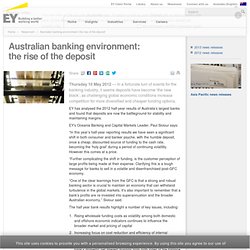
EY has analysed the 2012 half-year results of Australia’s largest banks and found that deposits are now the battleground for stability and maintaining margins. EY’s Oceania Banking and Capital Markets Leader, Paul Siviour says: “In this year’s half-year reporting results we have seen a significant shift in both consumer and banker psyche, with the humble deposit, once a cheap, discounted source of funding to the cash rate, becoming the ‘holy grail’ during a period of continuing volatility. However this comes at a price. “Further complicating the shift in funding, is the customer perception of large profits being made at their expense. The half year bank results highlight a number of key issues, including:
Attention: If You Have Australian Bank Stocks – Sell Them Now. Bigger is better for mortgagees. Feeling the squeeze: European banks pull $7.5b from Australia. EUROPE'S troubled banks accelerated efforts to pull loans from countries around the world, including Australia, towards the end of last year as the euro zone debt crisis intensified.
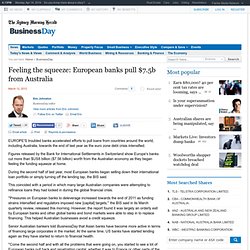
Figures released by the Bank for International Settlements in Switzerland show Europe's banks cut more than $US8 billion ($7.56 billion) worth from the Australian economy as they began feeling the funding squeeze at home. During the second half of last year, most European banks began selling down their international loan portfolio or simply turning off the lending tap, the BIS said. This coincided with a period in which many large Australian companies were attempting to refinance loans they had locked in during the global financial crisis. Advertisement ''Pressures on European banks to deleverage increased towards the end of 2011 as funding strains intensified and regulators imposed new [capital] targets,'' the BIS said in its March quarterly review, released this morning. Leave banking to the experts. Something rotten in state of Qld.
Major Banks Analysis pwc. Banking on a better future Welcome to Major Banks November 2013 - our analysis of the major banks' full-year results. FY13 has been another strong year of results for the Australian major banks reflecting solid profit growth in both the first and second halves. They have increased underlying cash earnings by 9.5% year-on-year (yoy) to $27.4bn. This translates to 4.2% growth in second half underlying cash earnings relative to the first half hoh. Rate moves telegraph banking strategies. Just how the big four banks adjust their interest rates this week and next will give us some flavour of their strategies around growing market shares in the mortgage market and the extent to which they are prepared to fight for deposits.
National Australia Bank's move on Wednesday to reduce its standard variable interest rate by 32 basis points says plenty. $1.5bn windfall for doing nothing. Skinny scales best for piggy banks. National Bank gains mortgage market share, but return to equity is eroded. Global model giving way to regional banks, says ANZ chief Mike Smith. Www.pwc.com.au/industry/banking-capital-markets/assets/MBA-May12.pdf. Www.afr.com/rw/2009-2014/AFR/2012/01/30/Photos/94771b7e-4b0e-11e1-b5ea-6e5870fefb10_Australian and Canadian Major Banks 300112.pdf.
Fitch puts Commonwealth Bank, NAB, Westpac, ANZ on ratings watch negative. AUSTRALIA'S four largest banks were placed on rating watch negative by Fitch Ratings today, which said the lenders continue to have a weaker funding profile than similarly-rated peers. Following a special report on the major banks of the commodity-driven economies of Australia and Canada, Fitch placed the long-term issuer default ratings and viability ratings on rating watch negative. The ratings and outlooks of Canada's six major banks were left unchanged. Australia's four largest banks are Commonwealth Bank of Australia, National Australia Bank, Westpac and ANZ Group. "These banks continue to have a weaker funding profile than other similarly rated peers," Fitch said in its report. "In addition, the agency notes that Australian and Canadian banks are each subject to many of the same themes and trends as other banks globally including an uncertain macroeconomic environment and evolving regulatory regimes.
" Loss at BOQ a symptom of fragility across the regional mortgage belt.